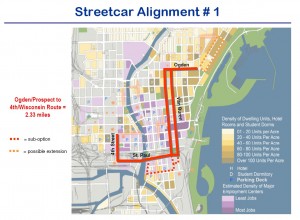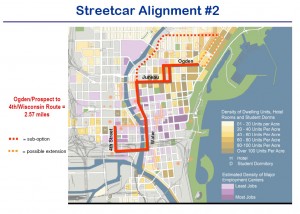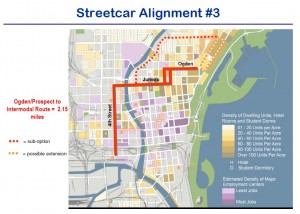Milwaukee Streetcar Routes Unveiled by Mayor Barrett
On Friday, Mayor Tom Barrett unveiled three streetcar routes under study to the attendees of UEDA’s Community Development Summit.
The Mayor walked through the three possible routes and numerous possible future extensions. He broke down how successful systems in cities such as Seattle, Portland, and Tacoma have started with routes similar in length to the proposed for the Milwaukee Streetcar system (2 to 3 miles).
The public is invited to attend an open house to review and comment on the proposed routes on October 8th, 2009 from 3 p.m. to 7 p.m. at the Zeidler Municipal Building at 841 N. Broadway.
Likewise, this system is outside of the purview of MCTS and their funding issues. It is certainly a piece of a larger regional transit solution, but the lack of a transit authority with dedicated funding is not a reason to stop working to actually utilize 18-year-idle federal funds. That said, we still believe a regional transit authority with dedicated funding is vital to developing a healthy, regional transit system. Thankfully Jim Doyle has proposed a plan to address just that, and now it’s up to our state legislators to act.
We invite you to vote in the below poll for your favorite route (and leave a message in the comments why), here is some quick food for thought from us. You’re also invited to buy a streetcar t-shirt, and wear it to the event on October 8th to show your support.
Alignment #1
- This route seems positioned for success because it connects likely riders (urban residents) with jobs. The Third Ward and downtown are filled with “creative class” jobs, and downtown and the lower East Side are filled with “creative class” workers. Likewise this streetcar would connect service industry workers with numerous restaurants, bars, and retail locations, saving money for the people who need it most.
- The jog up to Brady is more valuable than the jog further south in the Third Ward. Adding access for thousands of residents by connecting to Brady is more desirable than getting to the front door of more jobs in the Third Ward. It seems likely that if riders were dropped off by the iconic Milwaukee Public Market they would likely walk to the jobs located south of St. Paul in the Third Ward.
- Development potential along this route is good, although secondary to the potential for riders. This is key in this author’s viewpoint for making the starter system successful.
- Connection to the Intermodal Station is essential for regional transit (Amtrak, KRM, Megabus, Greyhound, etc).
- The 4th Street jaunt at the west end of the route seems likely to be underutilized, with likely only convention attendees and a few hotel guests using the leg. It might be better waiting until funds are available to make the 4th Street leg go further north.
Alignment #2
- The Water Street leg seems to pass less housing than Alignment #1 would. On the flip side it would likely pass more jobs, and more bars. It seems that a better balance would yield better ridership for the starter system.
- The potential Brady Street leg is intriguing, but likely a disappointment in terms of development. The Water Street portion could see more accelerated development, because of the line’s construction (The North End’s development would likely be accelerated). The Brady Street portion would draw riders, however, future growth may be difficult because of neighborhood politics including the East Village Neighborhood Conversation Overlay District that limit heights and thereby inhibits density beyond a certain level. Additionally, Brady Street itself is a historic district, which could limit the possibility of new development as well. Long-term development potential from the line on Brady Street is likely fairly limited (compared to other potential routes).
- Connection to the Intermodal Station is essential for regional transit (Amtrak, KRM, Megabus, Greyhound, etc).
- The 4th Street jaunt at the west end of the route seems likely to be underutilized, with likely only convention attendees and a few hotel guests using the leg. It might be better waiting until funds are available to make the 4th Street leg go further north.
- The alignment is less connected with the Third Ward, a large center of jobs, and is even further disconnected with the growing number of apartments at the east and southern areas of the Third Ward.
Alignment #3
- The alignment misses a large portion of East Town, the most jobs-dense portion of the city.
- The alignment serves many major entertainment hubs (Bradley Center, US Cellular Arena, Milwaukee Theater, Turner Hall Ballroom, Midwest Airlines Convention Center), which are likely to generate high ridership, but only on a handful of days.
- The alignment misses the Third Ward completely, a large jobs center, and an increasingly dense population center.
- The potential Brady Street leg is intriguing, but likely a disappointment in terms of development. The Water Street portion could see more accelerated development because of the line’s construction (The North End’s development would likely be accelerated). The Brady Street portion would draw riders, however, future growth may be difficult because of neighborhood politics including the East Village Neighborhood Conversation Overlay District that limit heights and thereby inhibit density beyond a certain level. Additionally, Brady Street itself is a historic district, which could limit the possibility of new development as well. Long-term development potential from the line on Brady Street is likely fairly limited (compared to other potential routes).
- The leg from Ogden to Brady would be important to generate ridership on the route, but it’s hard to imagine many people riding it to work daily.
- The route has the greatest development potential of the three routes, with all of the Park East covered. Unfortunately, that comes with the trade-off of likely the lowest ridership.
- If the goal is to build a starter system with the greatest number of riders possible, this is the worst option.
[poll id=”2“]
Urban Milwaukee has produced a limited number of Milwaukee Streetcar t-shirts, available for $15 a piece.
More about the Milwaukee Streetcar
For more project details, including the project timeline, financing, route and possible extensions, see our extensive past coverage.
- Another Streetcar Collision - Jeramey Jannene - Jun 27th, 2025
- Streetcar Hit By Apparent Red Light Runner - Jeramey Jannene - Jun 16th, 2025
- Streetcar Will Run On Consolidated Route During Summerfest - Jeramey Jannene - Jun 11th, 2025
- City Hall: Milwaukee Must Replace Failing Streetcar Switches - Jeramey Jannene - Feb 24th, 2025
- Streetcar Confronts Limited Funding, Operations Challenges - Evan Casey - Jan 22nd, 2025
- Council Kills Streetcar’s ‘Festivals Line’ - Jeramey Jannene - Jul 31st, 2024
- Streetcar Will Use Festivals-Oriented Route Through Summer - Jeramey Jannene - Jul 9th, 2024
- The Hop’s Lines Will Merge For Easier Summerfest Service - Jeramey Jannene - May 30th, 2024
- Streetcar Begins Daily Service To The Couture, BRT Will Soon Follow - Jeramey Jannene - Apr 11th, 2024
- Milwaukee’s Three Streetcar Extensions Need Mayoral Direction - Jeramey Jannene - Nov 8th, 2023
Read more about Milwaukee Streetcar here
























Seems that the first option would have the highest projected ridership? Gotta go with whatever fetches the highest ridership with the starter system, the purpose of transit is for people to ride it, and that should help with extensions when the time comes.
I’d say option 2 would be the best since it is most centrally located in the downtown to serve both east town and west town. Though I read that the streetcar may not have it’s own dedicated lane or have street lights turn green automatically for the streetcar? If that is true then don’t even bother with the system, it’s going to be no different than the bus in that it will get caught in traffic, like a bus, travel and a low average speed, and not run on a set schedule.
I went with #1. Although I think it would be better if the 4th Street leg was scrapped and instead the line extended up to Brady Street– thereby reaching a larger population of possible riders.
#1 looks best. Connects intermodal station with U.S. Bank Center (this is critical, it’s the largest office building in the state), NW Mutual HQ, Fed courthouse, Cathedral Square, Third Ward, MSOE, Metromarket, Mil. Public Market, close to 411 E. Wisconsin and Pfister, and connects all of that with densely populated east side.
I agree with Nathaniel, If people don’t ride and the system is not immediately successful, it will be crucified by the likes of Talk Radio. A streetcar system has been blocked for years, so it needs to hit the ground running if it comes about. The public must get behind it or it will be shelved for another 15 years.
I like #1 for the simple fact that it goes through the central business district, while incorporating some entertainment venues.
Great as always Dave.
@Mike
Dave appreciates the thanks (believe me he does), but I actually wrote the article. We had a little mix-up that credited him as the author. Thanks for the positive comments though!
An even better route would start at the intermodal station, go north on 4th to Wisconsin Avenue, then east along Wisconsin Avenue to Jackson/Van Buren, then north to Ogden, then east to Farwell. Why not run this thing on Wisconsin Avenue, which is downtown’s main street?
I think option 1 with the extension would be great, and I would actually trade the extension for the small segment that goes from the station to Wisconsin since that segment will be very underutilized.
@Andrew, I think there is a lot of consternation with the BRT folks from the county about having both lines on the same street (which to me seems ridiculous, but it is what it is). Might be a congestion/speed of service issue with Wisconsin too (not sure).
Hopefully #1 is what is built, with the extension to Brady. This brings together a nice mix of tourist destinations, jobs, housing, and nightlife. Hopefully if KRM and the county’s BRT plans move forward there will be easy transfers(no extra fees/thoughtful placement).
Great as always to you too Jeramey!
@Mike Yeah, this one is a Jeramey article… A little technical glitch messed that up initially.. But thanks!
Great news. At a glance, I prefer route number 1, though I agree that the 4th street leg seems unnecessary. You’d be quicker walking the 0.30 miles from the intermodal station to the convention center than waiting for a streetcar.
Also, this route passes under 794 via Van Buren and Jackson. It seems this routing would severely limit the potential for tidying up the knot of highway ramps at this location or implementing a surface level boulevard. Perhaps a crossing closer the river would be better in this regard? Is the trade-off worth it?
I see many of your arguements for route 1, but remember that we also have a proposed COMET system that would, if built, run norh on Prospect and south on Farewell with stops along that corridor. So, do we want duplication? You need to look at the systems together. Or is this proposal replacing the COMET…I thought it was the new route for the downtown circular streetcar
OK, after further review route 1 looks the best option considering the current land use, but 2 could lead to new development along the water street corridor and park east. I am torn….to with what will work now or what could create more growth in a under utilized area of the downtown.
regardless of where the route is they MUST have a dedicated lane for the vehicle and they must have the street lights turn green for the vehicle so that it’s movement is not stoped for traffic lights. This mode needs to be significantly quicker than the existing buses and in needs to be on time at stops or it won’t be used.
Outstanding. Let’s roll!
Inevitable critique: Barret’s choice of metaphor is horrible. A Trojan horse? If anything will get the anti-streetcar nuts riled up it’s language like that. This isn’t a sneak attack on an enemy city!
I think option 1 hits the greatest number of commuters and would provide walkable access to all the entertainment destinations available downtown.
One question that will hopefully be answered at the meeting is how many cars will run on this line?
Personally, I would hope there will be no schedule, instead you can expact that a train will be along every 5-10 mins. Unfortunately, given the length of this starter system, if it has a schedule like our current buses it would probably still be easier to make the 30 min walk downtown rather than wait 30 min for a ride.
I voted for #1 as the best of the lot but I think that the first route should definitely include going all the way to UWM period. Otherwise I don’t think it will be successful as it could be. I know that it would take more $ but then an unsuccessful route is wasting what we have and puts a pall on further development.
For maximum economic development as well as school/job ridership I would include route north of Brady that would include Downer and Oakland shopping centers, that mirrors the “30” and “15” routes that are the most successful of the present bus routes.
This would be the “Dream Route” for a successful first run of the street cars in Milwaukee.
I think option #1 is the best of the three but it really needs to run at least North Ave. I really can’t imagine that the streetcar is going to blaze though the short route in a way that will far surpass the bus system. I live a few blocks of North and the 30 only takes 20/25 min for me to get to work (4th & Wis) and the 15 about 5 min less. I know people who live along the proposed route that drive and I really don’t forsee then giving up cars for this. Its the people on the fringes of downtown (less economically well off) who really need quick and fast transit versus people who live in 400k condos or pay 2k a month in rent. I know we have to start somewhere, but I think the starting point needs to be a bit larger.
If the line could be extended at least to North Ave, that would capture a large number of UWM students, especially since UWM is running those shuttles between the Kenwood campus and North Ave. Yes, it would require a transfer to get downtown where the 15 and 30 wouldn’t, but unlike the 30 or 15, it would allow you to get to the Intermodal station with luggage. Better would be all the way to UWM.
Joyce
I think what hasn’t been made clear here is that there is only enough money for about 2 miles. Of course it would be great to get to North Avenue or UWM. It would also be great to get to Marquette, Bay View, Bronzeville and many other locations but there is only enough money for 2 miles.
I lived on the Eastside (Prospect and Brady area) for many years, in the Third Ward for a year, attended UWM for undergrad and grad school, worked downtown for two years and honestly, I don’t think I would have ever ridden the proposed streetcar.
I owned a car but often tried to survive without it by using the 15/30 buses. My thought is that “Milwaukee Urbanites” will adapt to this system if it perhaps connects UWM to Marquette and runs through the Third Ward / Downtown / East Town / Brady / North / probably a few other locations… otherwise the bus seems more convenient.
Maybe we’re “building a bridge halfway over the river” because that’s all the money we have? (I know not the best analogy) and I could be totally wrong about this… maybe there are enough people who regularly need to go between East Town and Downtown for this too work.
I think Urban Milwaukee staff should create a different poll, such as: if you are a “Milwaukee Urbanite” would you use the streetcar? Y / N
Also, I’m wondering if any transportation engineering types have weighed in on this.
And one more thing… thank you Urban Milwaukee. Someday I plan to move back to Milwaukee but I feel like I’m not missing anything because of your site.
Michael, one of the benefits of a streetcar is that it won’t just attract us urbanites, it will attract almost everyone. There are a lot of people who live on the lower east side who now drive to the Third Ward or downtown. I know that sounds crazy, but it’s true. The bus is not appealing to them for a number of reasons (confusing, infrequency of service, misconceptions, etc.). The beauty of enhanced transit options like a streetcar is that they can help increase transit ridership as a whole, because they appeal to a larger group of potential users.
It would be nice to see the proposed stops on these maps as well.
I like option 1 best with the deeper into the 3rd ward option. It should also extend up to Brady and ultimately to the UWM campus if they really want it to be heavily utilized.
@Matt Agreed I like it going deeper into the Third Ward, and would like it to go all the way to brady st before it turns around, but option 1 is still a pretty solid route as is.
Jeramey, I’d just remind you there are thousands of residents in the Third Ward also – not just jobs. Not that I’m biased.
@Michael James “Someday I plan to move back to Milwaukee but I feel like I’m not missing anything because of your site.” // doesn’t this site make you long for what you ARE missing?! 😉
RE: the 4th st jog…
From a transportation engineering standpoint: Granted, never underestimate an American’s willingness to shell out $$ to be moved 4 blocks without walking, but still, this leg doesn’t seem to make much sense.
From a political/marketing standpoint: There’s zero chance this thing gets build WITHOUT being paraded around in front of the convention center. And there’s the end of discussion for that leg!
In addition to the convention center, it might be important for the streetcar to make an appearance on Downtown’s main drag west of the river.
Something else I have been wondering about…I’m assuming the streetcar line and the vehicles themselves will need some sort of maintenance shed. Looking at alternative 1, it seems to me that one of the best places for this building to go would be in the 4th and Clybourn Area. I assumed that was another reason why that particular little jaunt. Any other ideas where it could go?
I have to go with the consensus on #1. Simply because of projected ridership and the fact that #3 just leads to sports arenas and a empty and unused mall and #2 seems to follow only nightlife not linking any of the East town residences to third ward and downtown
Have you guys (Dave and Jeramey) heard anything more about a locally preferred alternative? I know that milwaukeeconnector.com gave a timetable with a “locally preferred alternative approved” in December 2009 to January 2010. Would the City Common Council be in charge of choosing this alternative? The City engineering department?
@Kevin I think there will be much more on the Streetcar next month.